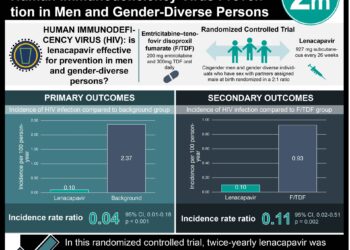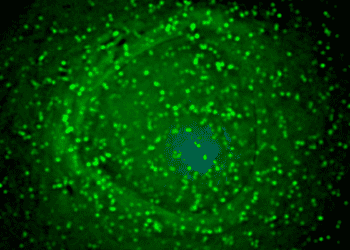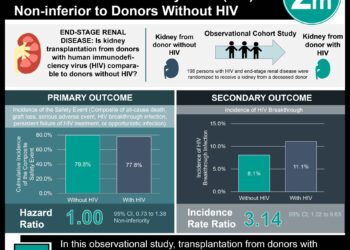New pathogenic dimorphic fungal species suggested in HIV-positive patients
Image: PD/HIV-1
1. A novel fungal species was identified in a cluster of cases of disseminated fungal infection in HIV-positive patients.
2. DNA-sequencing did not match any known species but was most closely related to E. pasteuriana.
Study Rundown: This study identified a novel fungal pathogen associated with disseminated infection in a series of human immunodeficiency virus (HIV)-positive adults. However, the lack of established rules in molecular taxonomy makes the definition of a new taxon difficult, and so the authors did not name the isolate. As indicated in the study, the clinical presentation of disseminated infection by this agent resembled that of tuberculosis (on chest X-ray), sporotrichosis, and histoplasmosis in various aspects. Given that this fungal species is sensitive to azoles and amphotericin B, the new discovery is likely to have only limited clinical impact until more is learned about the organism such as a better understanding of its biogeoclimatic distribution.
Click to read the study, published today in NEJM
Click to read an accompanying editorial in NEJM
Relevant Reading: Emerging disease issues and fungal pathogens associated with HIV infection
In-Depth [case series]: This study identified a novel fungal species in 13 HIV-positive patients with disseminated fungal infection in South Africa. Clinically, pulmonary presentation mimicked tuberculosis on chest X-ray. Most patients responded to amphotericin B treatment.
The organism was thermodimorphic, existing in a mycelial phase at 25°C and 30°C, and yeast phase at 37°C. In mycelial phase, colonies grew to 15-25 mm after 7 to 14 days and up to a maximum of 50-60 mm in 21 days. Colonies appeared glabrous early on with a folded, wrinkled or cerebriform appearance and became light brown with powdery segments over time. In yeast phase, the colonies were smooth with cream-to-beige color. The yeast cells were small, thin-walled, globose-to-oval shape. The organism was indistinguishable from E. pasteuriana both macroscopically and microscopically. Minimum inhibitory concentrations were higher for the echinocandins and flucytosine than for the triazoles and amphotericin B.
Sequencing analysis included large-subunit ribosomal DNA, internal transcribed spacer (ITS1-2) ribosomal DNA regions, and portions of the genes encoding beta-tubulin, actin, and intein PRP8. Sequencing showed that isolates from 12 patients (1 was not available for sequencing) were of a distinct and homogenous cluster within the genus of emmonsia and is most closely related to E. pasteuriana.
By Xiaozhou Liu and Adrienne Cheung
More from this author: Nivolumab plus ipilimumab shows promise for metastatic melanoma, Prophylactic platelet transfusions prevent bleeding in hematologic cancers, Azithromycin is not associated with increased cardiovascular death in low-risk groups, Health education module reduces parasitic infections, New chemotherapy precludes the need for radiotherapy in primary mediastinal B-cell lymphoma
© 2013 2minutemedicine.com. All rights reserved. No works may be reproduced without expressed written consent from 2minutemedicine.com. Disclaimer: We present factual information directly from peer reviewed medical journals. No post should be construed as medical advice and is not intended as such by the authors, editors, staff or by 2minutemedicine.com. PLEASE SEE A HEALTHCARE PROVIDER IN YOUR AREA IF YOU SEEK MEDICAL ADVICE OF ANY SORT.







